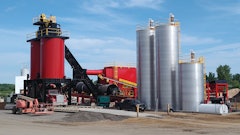
Compared to mill and fill alone, preservation methods such as slurry and micro surfacing and chip sealing consume less aggregate and binder—i.e., natural resources. The fact that they reduce the need to demolish, haul and dispose of (or even recycle) old pavements, coupled with the fact that they are quicker, cooler processes to apply, translates to a reduction in waste, emissions and greenhouse gases. Simply put, the carbon footprint from pavement preservation projects is lower than that from traditional asphalt paving.
Pavement preservation methods offer additional, less obvious green advantages as well. For example, because there is no need to establish a nearby aggregate source or hot-mix asphalt plant, dust from crushing and screening, additional emissions and energy needs are reduced. Roads are drivable within a short period after the treatments have been applied, reducing traffic delays and the associated greenhouse gas (GHG) emissions.
“In general, the longer a contractor is out there, the more energy and materials you consume, the more emissions and greenhouse gases you create, and the more risk there is to workers and the general public—it’s a snowball effect that pavement preservation keeps under control,” says Rusty Price, president and general manager for Intermountain Slurry Seal, a subsidiary of Granite Construction Inc.
Research Supports Benefits
Research backs Price’s logic. For instance, BASF Corporation's recent “Micro Surfacing Eco-Efficiency Analysis (EEA)” found that, compared to mill and fill techniques alone, micro surfacing consumes 40% less primary energy, uses 50% fewer resources by mass and creates 45% less green house gas emissions. Further, the BASF EEA report has been verified by NSF International, a not-for-profit, non-governmental organization accredited by the American National Standards Institute (ANSI) to develop standards and provide third-party conformity assessment services.
Laws surrounding emissions and storm water have no doubt made more contractors aware of pavement preservation’s green benefits than the agencies whose projects they fulfill. According to Price, “Those of us who work with chip seal, slurry seal, micro surfacing, etc., already know that these techniques are environmentally friendly. They require less materials and energy, and they create fewer emissions and less risk to the environment and the public. It should make sense to everyone that the green benefits are there,” he says. “Unfortunately, for agencies, the green aspect has so far been mostly ancillary to pavement preservation’s low-cost benefits.”
One exception, however, has been the Federal Highway Administration’s Central Federal Lands Highway Division and under this agency, the National Park Service. Charles “Chuck” Luedders, P.E., pavements engineer for the division, says that when a contractor deals with the National Park Service, every job has to have the environment in mind as a major concern.
Helping Preserve National Parks
Luedders says that within our national parks, pavement preservation, especially chip seal and micro surfacing, has been a good option for maintaining infrastructure assets—from a budgetary and green point of view. “The biggest advantage for most agencies is that pavement preservation extends budgets; for the most part, ‘green’ is a side benefit. For national parks, however, it is a primary benefit,” he says. “Their major concerns are the environment and the visitor experience. We are always providing information to them on the green benefits of pavement preservation and how quickly the work can be completed.”
In addition to the normal eco-friendly aspects to pavement preservation, the national parks require some special steps to be taken as part of their preservation projects. For instance, in most chip seal projects, loose aggregate can be swept to the side of the road. But in the national parks, it must be swept and hauled off of the park’s land because the stone is not native to the ecology. “Once the excess chips are vacuumed up, they’re taken to another location,” says Luedders. “The contractor can then sell them to homeowners, or if they are cleaned up and meet specification, they can be reused on the roadway.”
Price says that other national parks requirements include taking special care with emulsions to keep them only on the road surface and off of curbs, rocks and greenery. “We have to be careful transferring from the transport trucks to the spreaders, and also ensure that aggregate and emulsions stay out of storm drains and water sources such as rivers, lakes and streams. You have to know where the storm water goes every inch of the way and watch the weather,” he says. “You can’t lay an emulsion if there’s going to be a thunderstorm.”
Overspray of asphalt onto historic features is another concern, according to Luedders. In some national parks, even the stone curbing is considered historic, and must be covered with tape or protective paper. These requirements are typically written into the job specifications.
“With national parks jobs, we conduct pre-construction meetings to help employees remember that the environment is a top priority,” Price says. “But in general, we try to make the environment a priority everywhere we work. We don’t like upsetting anyone, whether they’re homeowners or agencies.”
Luedders agrees. “From a PR standpoint, for any such project, it’s a good idea to emphasize the green nature of pavement preservation. It gets the public behind the projects, as opposed to only looking at the cost as a reason to preserve,” he suggests.
[author bio]
Pierre Peltier, a 30-year pavement preservation industry veteran, is the president of the International Slurry Surfacing Association (ISSA) and general manager of marketing & business development at Terry Asphalt Materials, Inc. To contact Pierre, call (615) 630-2315 or email [email protected] or visit ISSA’s website at www.slurry.org.
[sidebar]
Pavement Preservation: A Sustainable Alternative
Pavement preservation fits well with the current interest in sustainable development. Defined as, “development that meets the needs of the present without compromising the ability of future generations to meet their own needs,” sustainable development tries to balance the needs of people, nature and the economy—and it includes green construction practices as part of its tenets.
Pavement preservation methods provide numerous environmental benefits, including reducing the consumption of natural resources and reducing emissions. At the bidding stage and beyond, it would certainly be beneficial for contractors to bring all of these points to the specifying agencies’ attention.
“I’ve said for years that there has to be more than a low bid. There has to be something of value besides finding the lowest cost,” says Rusty Price, president and general manager for Intermountain Slurry Seal. “Keeping the environment in mind is one of those added benefits.”

























